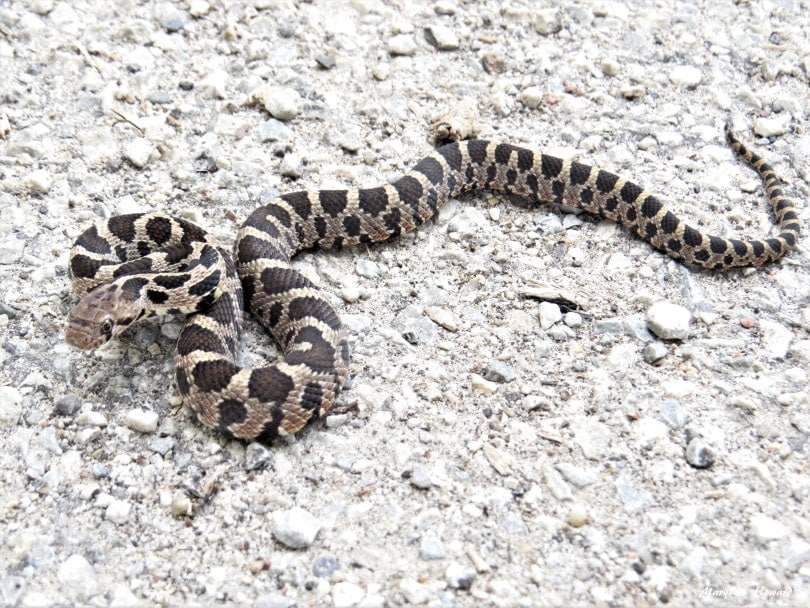What exactly is your interest in snake life in Ohio? Is it because you found a reptile dangling from the rafters in your garage? Did you meet a new face in your garden? Or maybe you just really love herpetology, scraping up all the knowledge you can.
Snakes are incredibly intricate creatures that come in an assortment of raw beauty. If you’re trying to identify a snake, or simply want to know what Ohio has to offer, you came to the right place. Let’s admire all of these captivating creatures.

The 19 Snakes Found in Ohio
1. Copperhead

| Scientific name | Agkistrodon contrortrix |
| Temperament | Non-aggressive |
| Danger | Highly venomous |
The copperhead is one of the most feared snakes in Ohio, as it is highly venomous—and common. Copperheads are known for their unique smell, giving off an aroma of freshly cut cucumbers (some would say.) This scent is actually a defense mechanism when they feel threatened or disturbed.
Copperheads are highly predatory, equipped with heat-sensing pits between their eyes. They hunt, bask, and roam a variety of landscapes, from wetlands to dense woodlands. Surprisingly, these snakes don’t act aggressively unless they feel they have no choice—striking as a consequence.
2. Racers
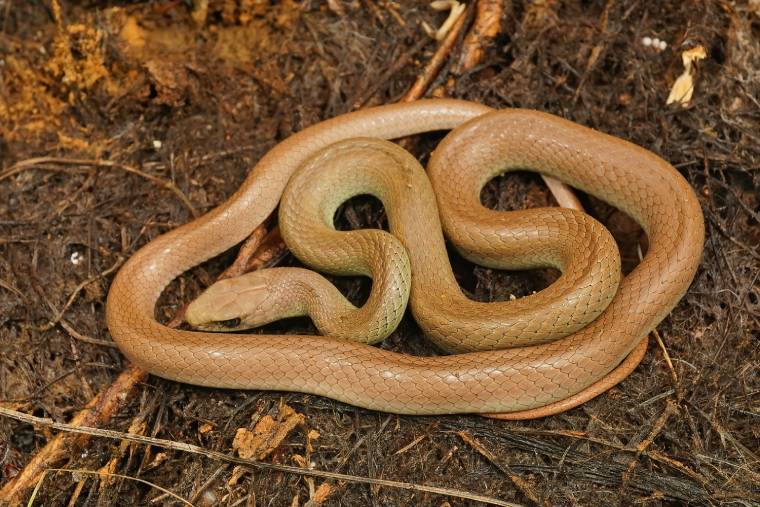
| Scientific name | Coluber constrictor |
| Temperament | Inquisitive |
| Danger | Non-venomous |
Racers are stunningly impressive, with their sleek, gleaming scales and lightning-fast speeds. Two different racers dwell in this state—the black and blue racer. They mirror with the only minor difference being color and nothing more.
These fidgety guys are very speedy and nervous creatures. If they feel threatened, they can even chase you to get you out of their space. However, they are non-venomous—and the likelihood of a bite is small.
3. Timber Rattlesnake
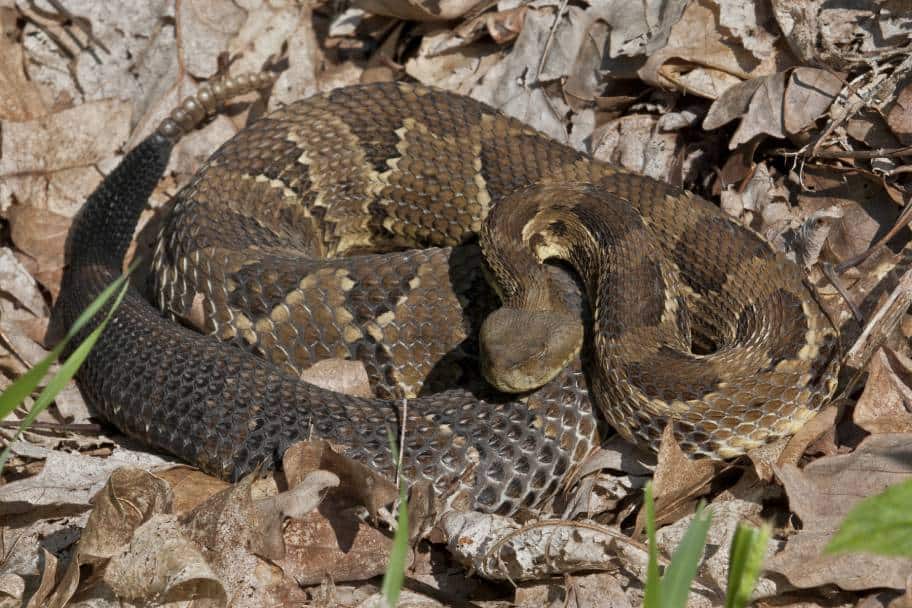
| Scientific name | Crotalus horridus |
| Temperament | Non-aggressive |
| Danger | Highly venomous |
This fierce rattler has to be the scariest snake in the state. The timber rattlesnake may give off a warning shake, they don’t hesitate to strike—delivering a toxic venom into the body. They are considered one of the most venomous snakes in the northern United States.
Interestingly, timber rattlesnake mothers give birth to live young. Even babies are venomous, coming fully equipped with a set of hollow fangs. However, snake bites by the timber rattlesnake are very rare, as these snakes don’t go out of their way looking for trouble.
4. Hognose Snake
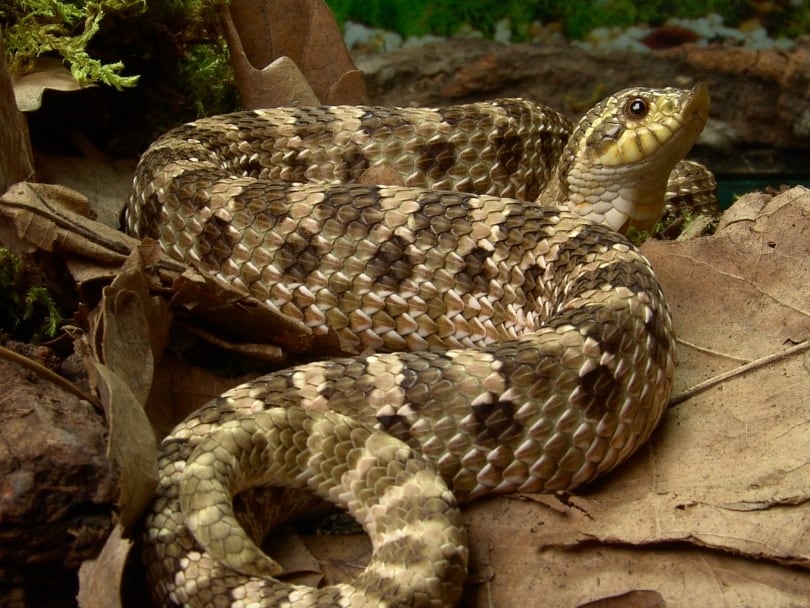
| Scientific name | Heterodon nasicus |
| Temperament | Mildly aggressive |
| Danger | Mildly venomous |
The incredibly intriguing hognose snake fits the name to a T, having noses that upturn, resembling pigs and hogs. You can find them across Ohio, inhabiting farmlands, woodlands, sandy areas, and fields. Their unique appearance has even landed them among the snake trade.
They can be a little bit territorially aggressive and challenging, but they usually will take bluffing over biting. Their bites release some mild venom, but nothing that could fatally harm a human.
5. Ribbon Snake

| Scientific name | Thamnophis sauritus |
| Temperament | Inquisitive |
| Danger | Non-venomous |
The ribbon snake is a thin reptile that has distinct lines down its body. Females are typically larger than their male counterparts—but both genders greatly resemble garter snakes, a common misconception. The ribbon snake has bands extending down the body.
These snakes are highly common in Ohio, and they are very harmless creatures. You might even see one take notice of you in the yard—watching you as much as you watch them. They can be easy to handle for their apparent curiosity, but be careful to hurt or startle the animal.
6. Queen Snakes
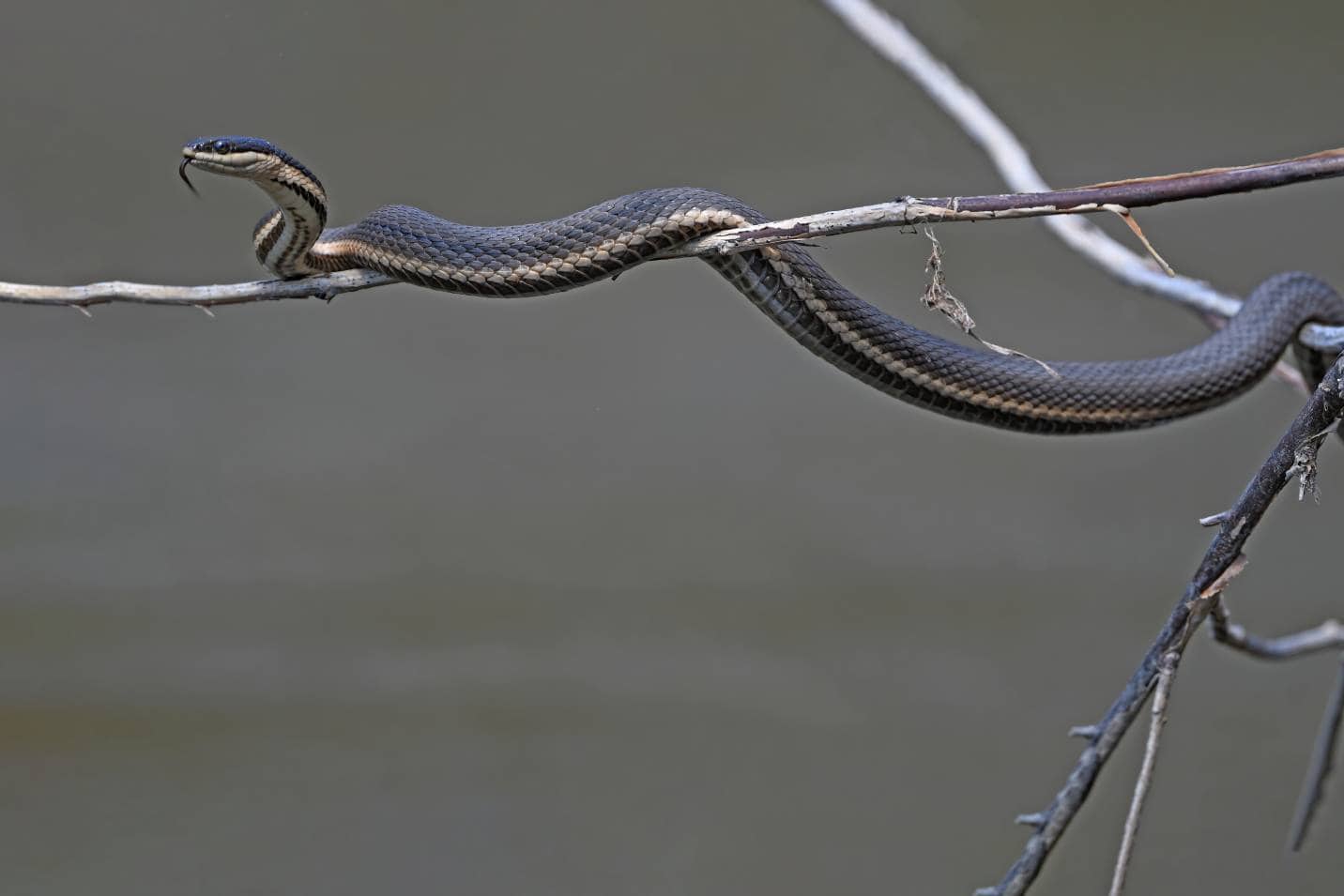
| Scientific name | Regina septemvittata |
| Temperament | Peaceful |
| Danger | Non-venomous |
Queen snakes are semi-aquatic water snakes that love slow-flowing water and hideouts along the banks. These little snakes are completely docile, but they do have a defense mechanism. They release a foul-smelling musk from their vents to deter the predator, so beware if you dare.
Unlike terrestrial snakes, queen snakes feast on freshly molted crayfish, snails, and minnows. These snakes like to keep to themselves and won’t be found basking in the open like some other water snakes.
7. Green Snakes
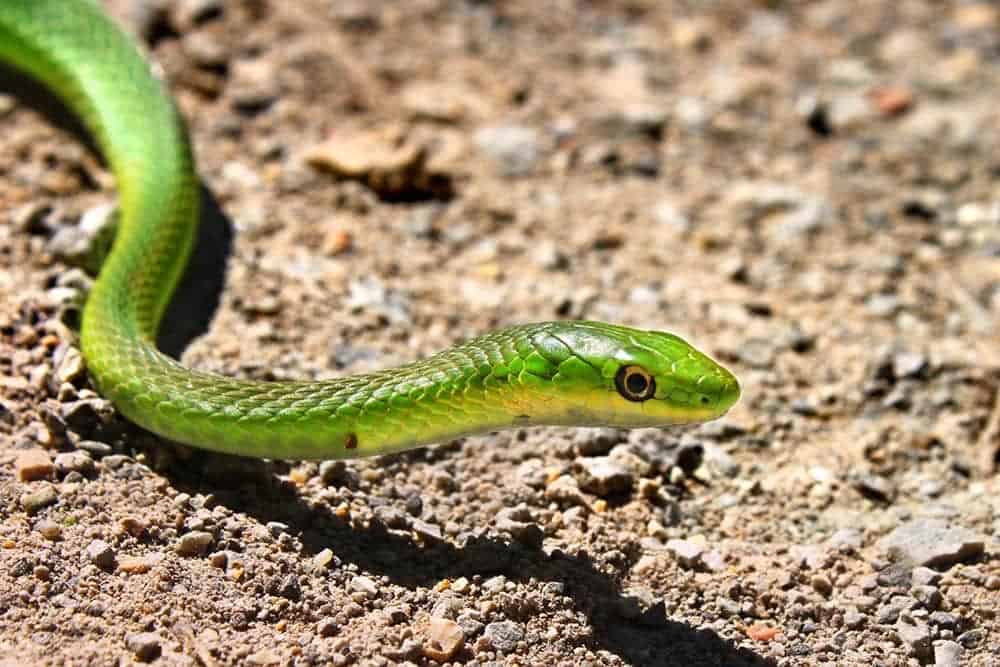
| Scientific name | Opheodrys |
| Temperament | Timid |
| Danger | Non-venomous |
Green snakes are a tiny, thin snake that doesn’t like being in the open. Due to their bright color and size, being in the open could attract an unwanted predator really quick, so they try to hide among tall grass areas like meadows, prairies and pastures.
Since they are so slender and match so well to their surroundings, you can walk right by one of these little guys completely unknowingly. Instead of eating small rodents, these snakes eat much smaller targets, like grasshoppers and centipedes.
8. Common Water Snake
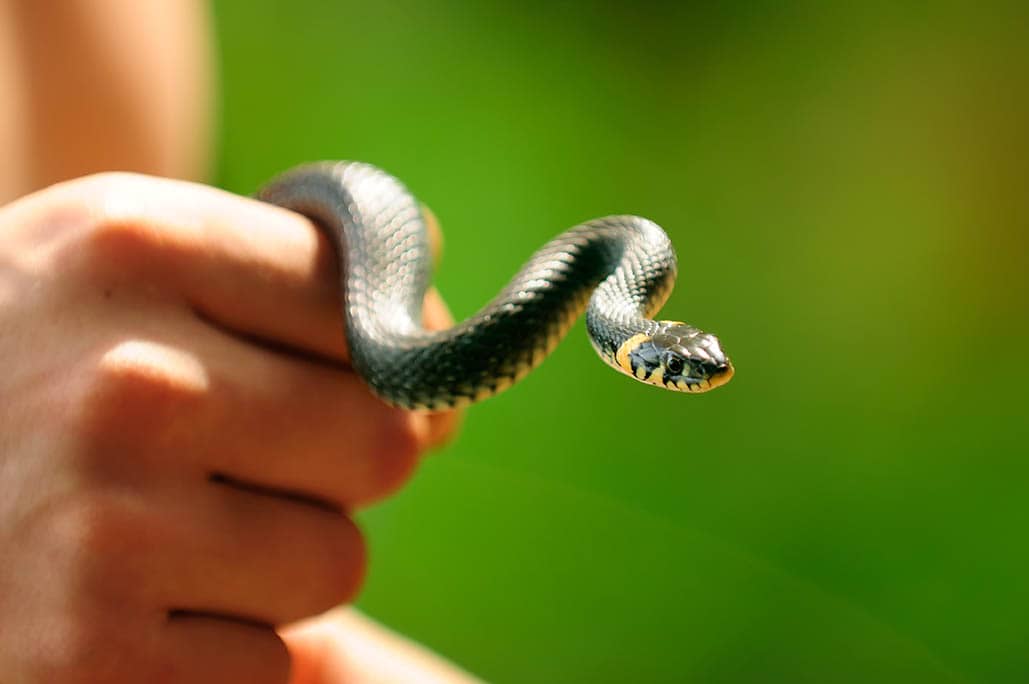
| Scientific name | Nerodia sipedon sipdeon |
| Temperament | Active |
| Danger | Non-venomous |
If you’re wading in a creek or river, the likelihood of seeing a common water snake above all other aquatic snakes is probable. These guys aren’t shy about their presence, basking on rocks and swimming on top of the water at leisure.
Unfortunately, these snakes greatly resemble the feared cottonmouth. Unless you have a trained eye, you might not be able to tell the difference, so always approach the situation with caution.
9. Lake Erie Water Snake

| Scientific name | Nerodia sipedon insularum |
| Temperament | Peaceful |
| Danger | Non-venomous |
Unlike the common water snake, the Lake Erie water snake is a much less common and endangered species in Ohio. You might never see one of these gorgeous specimens, but they do like large bodies of water.
They resemble other water snakes, being plainly colored and visually unremarkable. Opportunistic feeders, they snack on small fish and certain amphibians.
10. Worm Snakes

| Scientific name | Carphophis amoenus |
| Temperament | Shy |
| Danger | Non-venomous |
Like the name implies, a worm snake looks very much like an earthworm. It’s super small, nearly undetectable, and totally harmless. They usually live in the southern portions of Ohio, most commonly.
These snakes love to hide, protecting themselves from predators who want to have them as a tasty treat. Worm snakes are not venomous and they hunt at night, consuming earthworm, coincidentally enough.
11. Kirtland’s Snake

| Scientific name | Clonophis |
| Temperament | Shy |
| Danger | Non-venomous |
The Kirtland snake is a threatened North American species that can still be found sparsely in Ohio. These snakes inhabit dense forests and wetlands, favoring water sources—however, they are not aquatic.
Instead, they use their environment as a hunting ground, eating slugs, toads, and frogs. These snakes shy away from confrontation whenever possible. There are no reports of a human being bitten by this species.
12. DeKay’s Brown Snakes
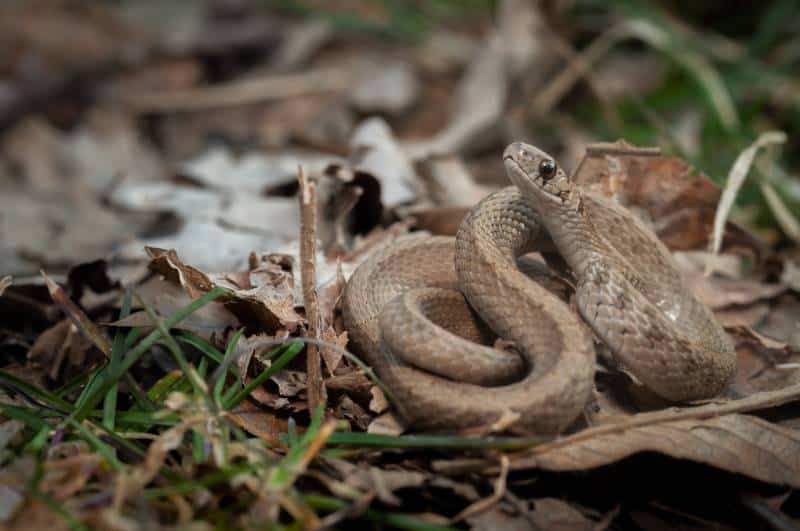
| Scientific name | Pseudonaja textilis |
| Temperament | Shy |
| Danger | Non-venomous |
The prevalent Dekay’s brown snake is a very popular snake face in Ohio. These snakes remain about the size of garter and corn snakes—and they can even be found hiding together. The brown snake prefers man made areas to natural habitats, hiding in old building or under wood boards.
These snakes are—you guessed it—various shades of brown. They are completely harmless to humans, but they prey upon slugs, snails, and larvae. Unlike other brown snakes, Dekay’s are not venomous, so they release a foul-smelling musk as a defense mechanism.
13. Northern Red-bellied Snake
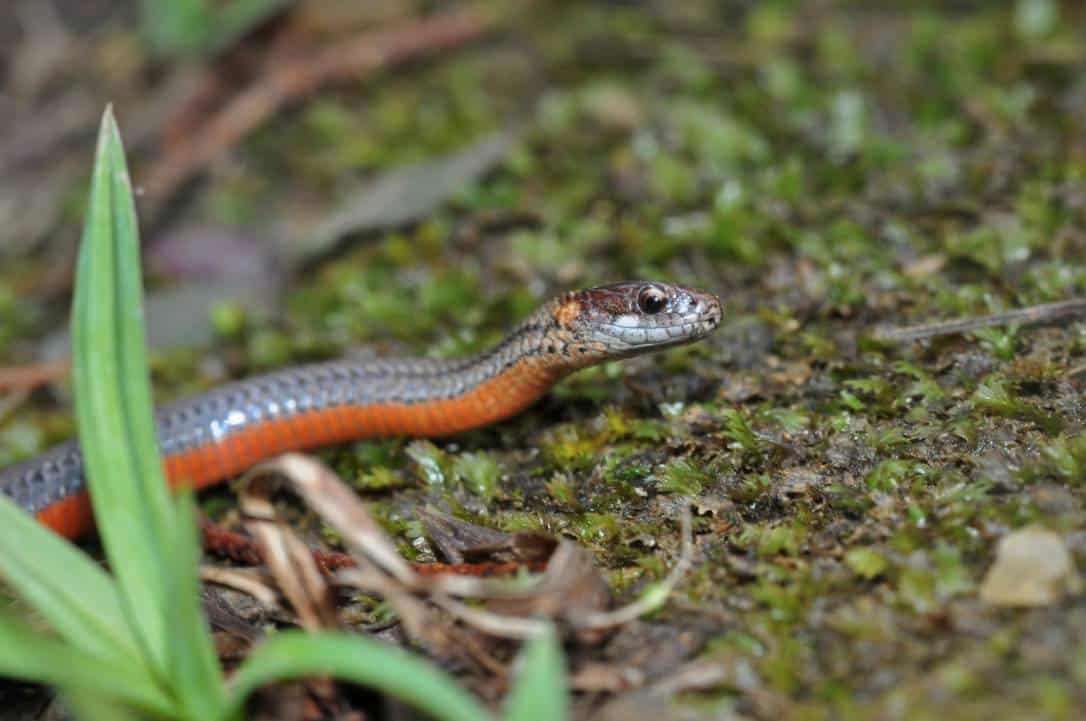
| Scientific name | S. occipitomaulata |
| Temperament | Peaceful |
| Danger | Non-venomous |
The northern red-bellied snake, or fire snake, is a less common specimen you might come across in Ohio. From the top, these may look like drab snakes a long much character. However, they have bright red fiery bellies—and when they get scared, they know just how to use their pop of color.
Even though these creatures are non-venomous and shy, their intimidating looks keeps predators at bay. Surprisingly, these snakes have a relatively short lifespan, living only about four years in the wild.
14. Ring-necked Snake
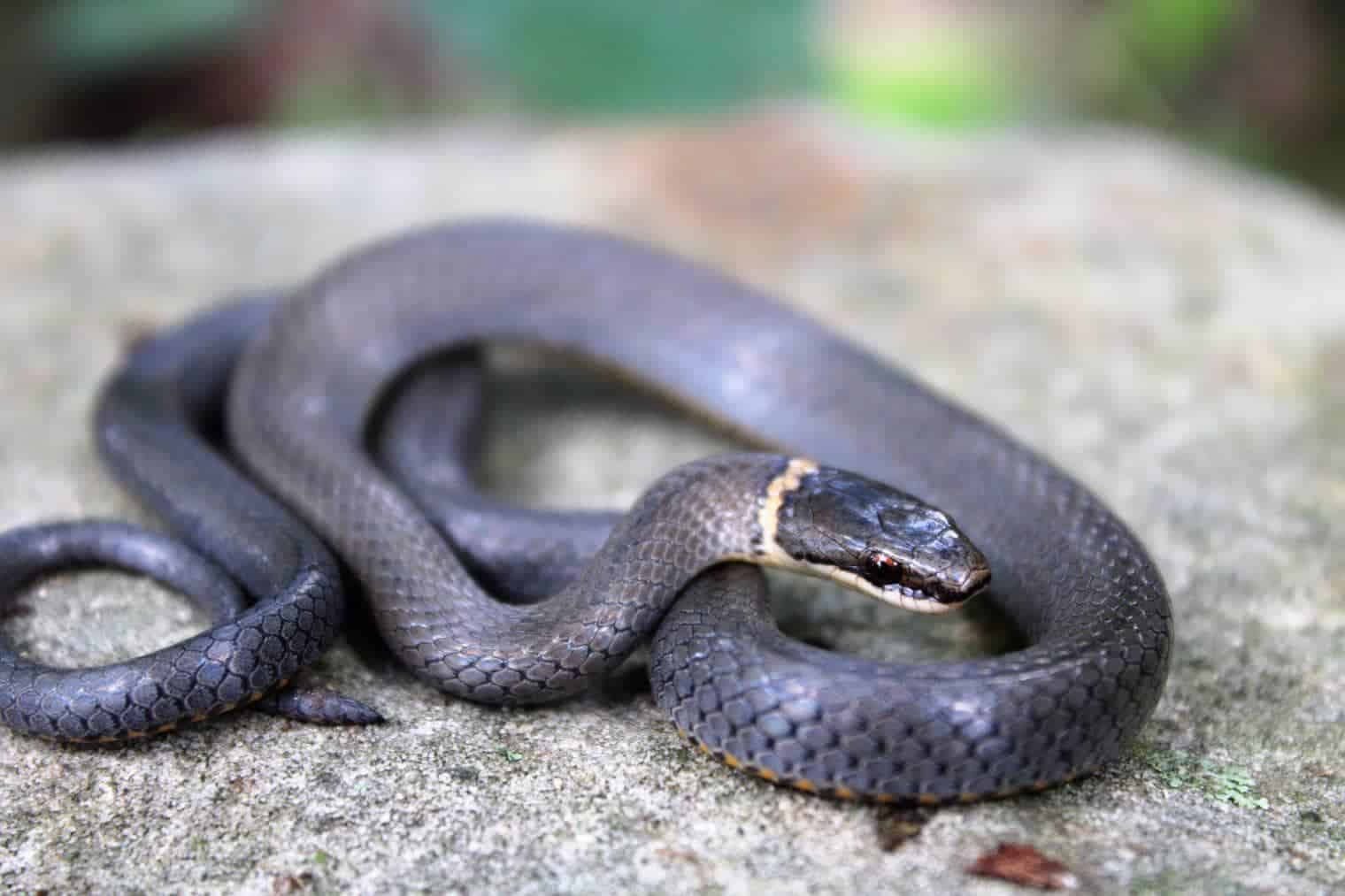
| Scientific name | Diadophis punctatus edwardsii |
| Temperament | Secretive |
| Danger | Mildly venomous |
Don’t let its impressive colors freak you out. These snakes are completely non-venomous and harmless to people. But when they feel threatened, they flash their vibrant underbelly to make the predator question.
These snakes are dispersed generously throughout Ohio—and all across the eastern coast. They might explore but they favor heavily wooded areas. Since these guys don’t get very big, salamanders and earthworms are the staples in their diet.
15. Eastern Milk Snakes
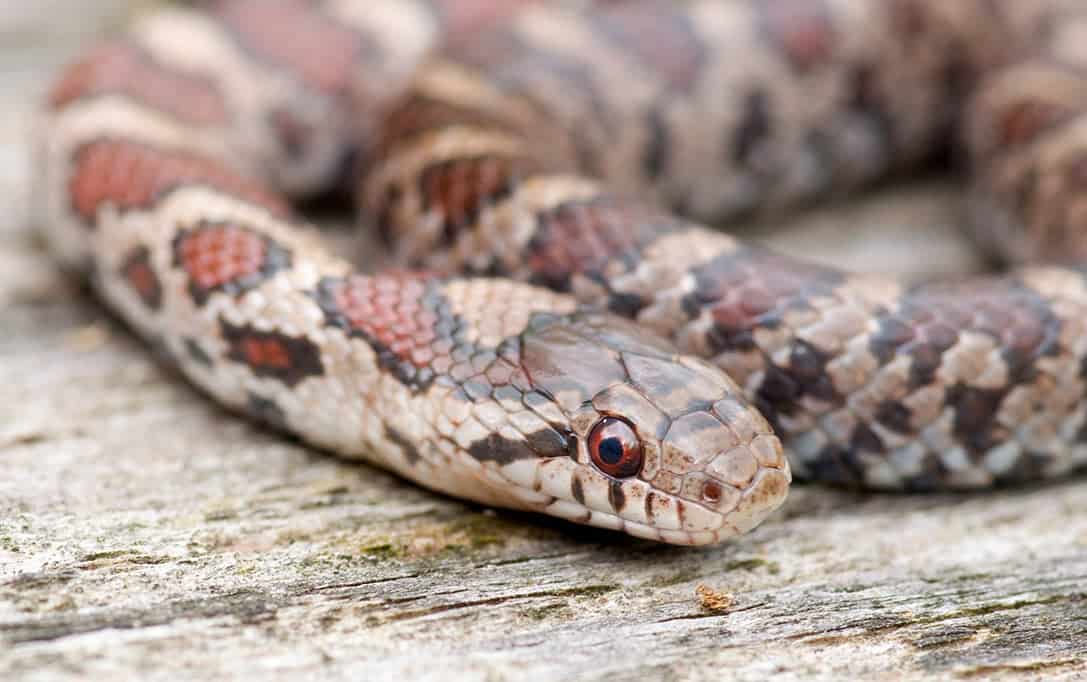
| Scientific name | Lampropeltis triangulum |
| Temperament | Docile |
| Danger | Non-venomous |
With their bold, brightly colored patterns, you might think you’d be in danger if you crossed paths with an Eastern milk snake. However, these non-venomous snakes are much more likely to duck for cover if you come by.
These snakes can survive just about anywhere in Ohio, but they seem to really love old stone foundations. You might find one of these guys under an old slab in a farm yard or in the basement of an abandoned house.
16. Garter Snake
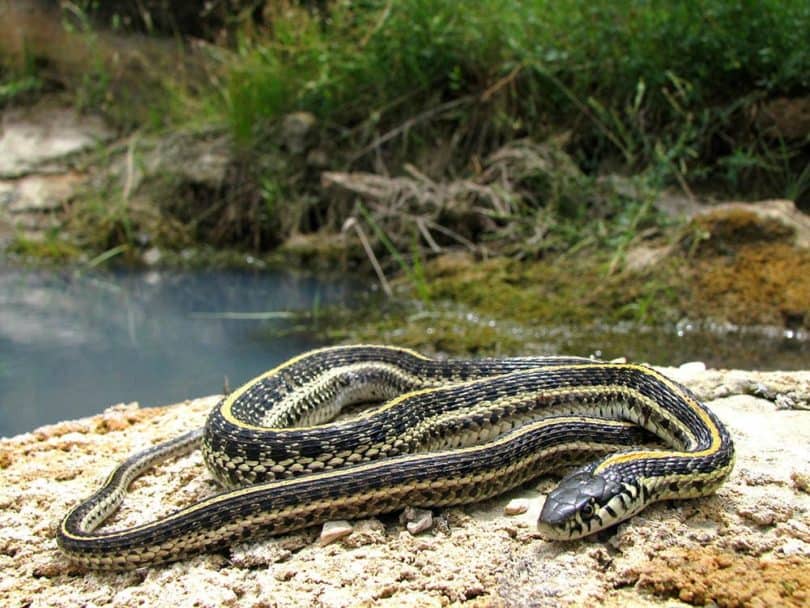
| Scientific name | Thamnophis |
| Temperament | Shy |
| Danger | Non-venomous |
Since garter snakes love yards, flowerbeds, and gardens, you have likely seen this snake a time or two. They have small heads, slender bodies, and lined patterns that give them away every time. There are a few different types of garter snake in Ohio, including the butlers, plains and regular eastern garter.
Garter snakes are completely harmless creatures that release a stinky musk if they get scared. While it might be unpleasant, it’s not dangerous. They don’t mind being in plain sight though, hanging out on rocks or climbing tree trunks to bask.
17. Eastern Rat Snakes
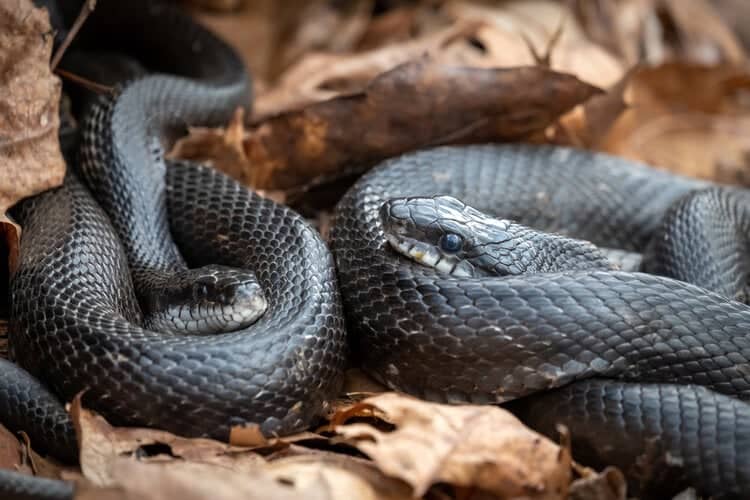
| Scientific name | Pantherophis alleghaniensis |
| Temperament | Mildly aggressive |
| Danger | Non-venonmous |
The Eastern rat snake is one of the largest snakes in Ohio, sometimes measuring over 100 inches as adults. While they are massive, they are usually docile—even though they can bite if they feel threatened (and it hurts.)
Rat snakes are sizable and prefer their prey to be as well. These guys eat rodents, birds, and even bird eggs. It’s not unusual to find this snake in the rafters of your chicken coops.
18. Eastern Fox Snake
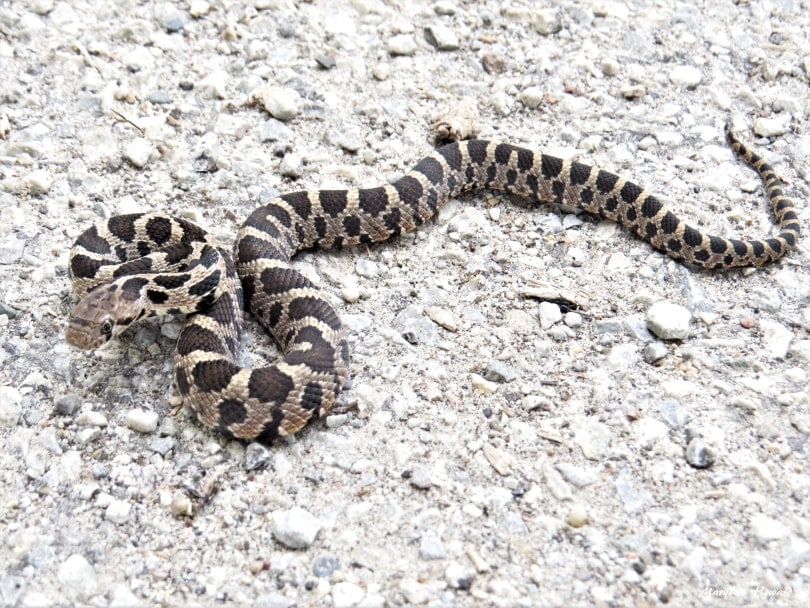
| Scientific name | Pantherophis gloydi |
| Temperament | Docile |
| Danger | Non-venomous |
The intriguing eastern fox snake is visually dissimilar to the red fox—however, the name is related. Some would say that these snakes emit an odor comparable to the smell of a wild fox.
These snakes are interestingly patterned with brown and black blotches. Since they love rock foundations. You can sometimes find them in older home with stone wall basements.
19. Eastern Black Kingsnake

| Scientific name | Lampropeltis nigra |
| Temperament | Docile |
| Danger | Non-venomous |
The eastern black king snake might look intimidating due to its size, but these guys are big softies. These snakes can have lines for markings, but many times they have more of a speckled pattern.
These big boys can take on some sizable prey—consuming rodents, eggs, birds, and even other snakes. These snakes are terrestrial and diurnal, meaning they hunt during daylight hours. One really cool fact about the king snake is it can rattle its tail when upset.

Conclusion
Even though other snakes might fall into these basic categories, these are the main serpents you might see in the land of aviation. Ohio has plenty of untapped territory for wildlife to explore, despite how populated it is.
If you come across a snake, make sure to check for questionable markings before ever handling it. Of course, it’s generally best to let snakes be if you aren’t an expert.
Related read:
Featured Image Credit: MLHoward, Shutterstock
